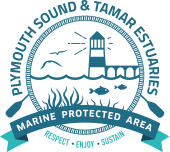Plymouth Sound & Tamar Estuaries Marine Protected Area is the perfect location to enjoy being out on the water, with iconic views and plenty of opportunities to encounter the local marine wildlife. There are also things you can do to help protect the MPA for future generations and make sure we enjoy our blue playground sustainably.
ON THE WATER
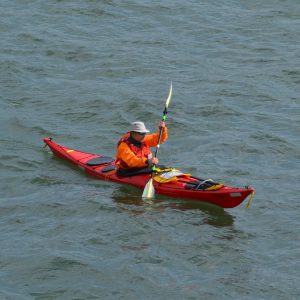
Kayaking & canoeing
Kayaking and canoeing is a great way to reach all areas of the MPA, taking time to explore sheltered coves, entrances to caves dotting the coastline, all the way to the upper reaches of the Tamar Estuary. There are great views to take in, as well as some beautiful wildlife, but do be mindful of the strong tides and currents throughout the marine site.
Remember that, although you may be quiet, birds and wildlife can still be disturbed by your visual presence – please maintain a good distance to prevent them from stress and potentially leaving their feeding or resting grounds. Please also use slipways to access the water, to avoid trampling, or dragging equipment over, sensitive habitats like mudflats, seagrass and saltmarsh.
Stand Up Paddleboarding
There are lots of opportunities for SUP around the MPA, with beautiful views and sheltered bays to explore. Particularly good spots to get into the water are Cawsand/Kingsand beaches, Bovisand and Batten Bay. There are also plenty of public slipways around the city that you can use to launch.
If you are launching from the shore, do be aware that we have a very large tidal range, and a lot of areas are rocky at low tide so access to and from the water can change quickly. Please be respectful of the habitats and species around the shore: avoid trampling or dragging your board over areas of seagrass, kelp or rockpools, and give wildlife plenty of space. Although you may be quiet, birds and other species can easily be disturbed by your presence.
Because Plymouth Sound is a busy working port, please avoid crossing the main navigation channels as vessels will be moving much faster than you, unable to manoeuvre around you and often may be unable to see you – particularly the larger commercial and naval vessels, and ferries.

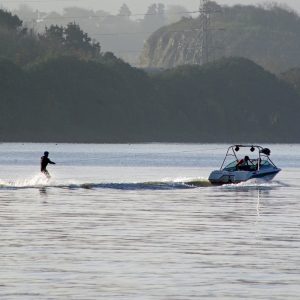
Jetskiing, waterskiing and wakeboarding
The Plymouth Sound & Tamar Estuaries are a busy traffic area, with marine life that is sensitive to noise and visual disturbance, as well as coastal areas that can be affected by wash from high-speed vessels. Speeds are regulated throughout the MPA but there are designated high-speed areas where you can enjoy these activities.
Please only use slipways to access the water and give plenty of space to wildlife, including birds, who can easily be disturbed by noise and physical presence. If you do see wildlife, please slow down, don’t chase or crowd the animals, and enjoy them from a distance. Please also be respectful of other water users and be aware that there are several designated swimming areas, surrounded by yellow marker buoys, that you should avoid entering.
Download our Water User’s Guide for speed limits and location of designated high-speed and swimming areas.
Windsurfing
You can enjoy windsurfing throughout the MPA, except in the main commercial shipping area of the Cattewater, where the activity is prohibited (the purple area shown in the image to the right). Take care in the Sound – it’s a busy shipping area, with lots of traffic, so avoid crossing the main navigation channels wherever possible.
To help us look after the MPA, please only use slipways to access the water, to avoid disturbing wildlife or dragging equipment over sensitive habitats such as mudflats or seagrass.
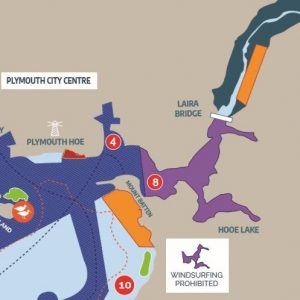
IN THE WATER
The Plymouth Sound & Tamar Estuaries MPA provides a rich and varied marine environment to explore and enjoy. Divers can enjoy the diversity of our habitats and species, but there’s so much to see that snorkelling is just as much fun. Help us to keep the marine site healthy – avoid causing damage to delicate marine species through finning, kicking or trampling, and don’t remove anything that belongs in the sea – take only pictures, leave only bubbles.
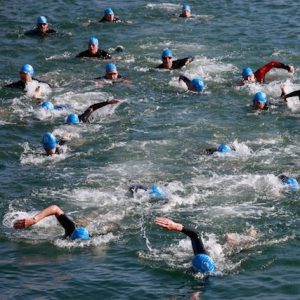
Swimming
There are some popular wild swimming spots around the Plymouth Sound & Tamar Estuaries MPA, including the Plymouth Hoe foreshore, which has nearby facilities and a designated swimming area within the yellow marker buoys all year round. Plymouth Hoe is also a designated bathing water, which means the Environment Agency monitor water quality and issue notices online if there are concerns and swimming should be avoided.
There are also designated swimming areas in Cawsand, Firestone Bay and at Bovisand (the designated is in operation whenever the yellow marker buoys are out). It is a busy area for recreational boating and watersports, so please do keep an eye out for other water users.
There are strong currents and tides at the site, so be aware of the tide times and plan your swims safely. Local tide times can be found at the bottom of our Activities page.
For more information on how to stay safe whilst swimming, visit the Devon and Cornwall wild swimming site.
Snorkelling
Exploring the marine life below the waves isn’t just for scuba divers! There’s so much to see along the coast that you’ll be spoiled for choice as a snorkeller. There are some great places to get into the water and discover the diverse and colourful species that make the MPA their home. Firestone Bay, Batten Bay, Jennycliff, Bovisand and Wembury are all ideal locations to don your mask and snorkel and see what you can find.
Whilst you’re out in the water, please be aware of the strong tides and currents, and keep an eye out for passing craft that might not see you in the water. It’s always a good idea to take a surface marker buoy with you, so you’re easily seen.
The creatures and species that you find are part of an important, balanced ecosystem, so please don’t handle or remove anything that you find, and avoid walking across habitats such as rockpools, seagrass or kelp.
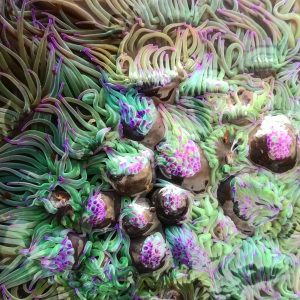
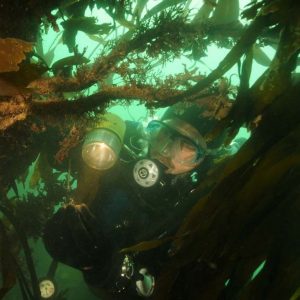
Scuba diving
The MPA and surrounding area offers rich diving , with beautiful cold water reefs, limestone drop-offs, kelp forests and wrecks to explore. We have some of the most diverse habitats and species in Europe, with the opportunity for shore diving from locations around the city, as well as boat diving out on the Eddystone, the Mewstone and wrecks including the HMS Scylla in nearby Whitsand Bay.
Within the Port of Plymouth, diving is only allowed with consent from the Queen’s Harbour Master, so please ensure that the organiser of your dive has the correct permissions and that Longroom Port Control Station (VHF channel 14 or 01752 663225) have been notified prior to diving, so they can inform you of any current dangers or hazards. Diving is also prohibited within 150 metres of HM ships and establishments.
BY THE WATER
From urban beaches to sheltered coves, rocky foreshores and wild stretches of hiking paths both at the coast and up into the far reaches of the Tamar Valley AONB, there’s much to see and enjoy around the Plymouth Sound & Tamar Estuaries. You can help to keep our shorelines and coastal areas pristine by taking your rubbish away with you, so that we can maintain the beautiful views and keep litter out of our waters. Please also be considerate of wildlife, giving them space and quiet in their own habitats.
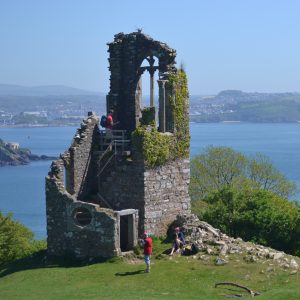
Coastal walks
The South West Coast Path is a superb way to the enjoy the Plymouth Sound & Tamar Estuaries Marine Protected Area (MPA), without getting your feet wet (although with Devon & Cornwall weather being what it is, we can’t guarantee it). With the help of some local ferries, it’s possible to walk the entire width of the MPA, from the Yealm Estuary in the South Devon AONB, all the way across to Rame Head in Cornwall, although we wouldn’t necessarily recommend doing it all one day – there’s far too much to see and enjoy along the route.
Visit the South West Coast Path website for walking routes and ideas.
Rockpooling
There are plenty of places around the MPA where you can go rockpooling, but our top spot has got to be Wembury Bay. With it’s rocky foreshore and wave-cut platforms that stretch out in the intertidal zone, it’s a magnet for a huge diversity of marine life to explore. Devon Wildlife Trust also run rockpool safaris from the Wembury Marine Centre, if you want a guide to help show you some of the amazing critters that make the rockpools their home. If you’re looking for some rockpool action closer to Plymouth, there’s plenty of cool stuff to find at Jennycliff and Batten Bay.
Please be respectful of animals and plants in the rockpools and be aware of tides changing. Remember to follow the seashore code and handle all wildlife with care. Only keep one animal in a bucket at any one time and make sure to put everything back where you found it.
The Marine Conservation Society have a great Seashore Safari Guide that you can download and take with you on your rockpooling expedition, to help you identify the creatures you find and make sure you look after the marine life for everyone else to enjoy.
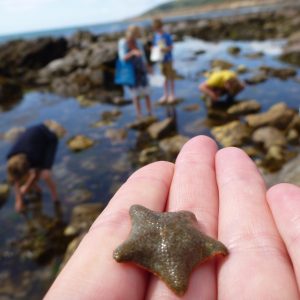
RNLI
Guides for staying safe at the coast
Whatever the activity, and no matter how experienced you are, understanding the risks and being prepared could save your life. The RNLI have safety advice on a range of different activities to make sure your visit to the coast is memorable for all the right reasons.
